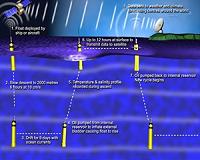| . |  |
. |
Paris (AFP) April 25, 2010 Oceanographers said on Sunday they had measured a system of mighty currents off Antarctica that are a newly-discovered factor in the equation of climate change. The system, known as Antarctic Bottom Water (AABW), is generated in clockwise movement in four big sea shelves that abut Antarctica -- the Weddell Sea, Prydz Bay, Adelie Land and Ross Sea. Extremely cold water sinks to the bottom of these shelves and slides out northwards along the continental shelf. At the edge of the shelf, some of the water mixes with a well-known ocean movement, the Antarctic Circumpolar Current, which sweeps around the abyss off Antarctica. The rest of the AABW, though, makes its way northward through a maze of ridges and gullies, reaching into the southern latitudes of the Indian and Pacific Oceans and into the Atlantic as far north as southern Brazil. The study, led by Yasushi Fukamachi of Japan's Hokkaido University, is published online in the journal Nature Geoscience. Fukamachi's team used an array of eight seabed sensors, anchored at a depth of 3,500 metres (11,375 feet) for two years over 175 kilometers (109 miles) on the Kerguelen Plateau, east of Antarctica, where current exits from the Prydz Bay shelf. On average, about eight million cubic metres (280 million cubic feet) of water colder than 0.2 degrees Celsius (33 degrees Fahrenheit) were transported northwards over this narrow section, the researchers found. That is four times more than the previous record documented in an AABW flow, at the Weddell Sea, on the other side of Antarctica. Over two years, the Kerguelen monitors recorded the current's average speed at more than 20 centimetres (eight inches) per second, the highest ever seen for a flow at this depth. The findings are important because ocean currents are major players in climate change. They circulate heat, moving warm waters on the surface to the cold ocean floor. After this water is chilled, it is eventually shuttled back by currents to the surface, for warming again. Currents also help determine the success of oceans as storage of carbon dioxide (CO2), the principal greenhouse gas. Microscopic marine plants called phytoplankton take in CO2 at the surface under the natural process of photosynthesis. When they die, the phytoplankton sink, but a current will determine whether they reach the ocean floor, thus sequestering the carbon for essentially forever, or whether they are swept back up towards the surface.
Share This Article With Planet Earth
Related Links Water News - Science, Technology and Politics
 Ocean Salinities Show An Intensified Water Cycle
Ocean Salinities Show An Intensified Water CycleCanberra, Australia (SPX) Apr 22, 2010 Evidence that the world's water cycle has already intensified is contained in new research to be published in the American Journal of Climate. The stronger water cycle means arid regions have become drier and high rainfall regions wetter as atmospheric temperature increases. The study, co-authored by CSIRO scientists Paul Durack and Dr Susan Wijffels, shows the surface ocean beneath ... read more |
|
| The content herein, unless otherwise known to be public domain, are Copyright 1995-2010 - SpaceDaily. AFP and UPI Wire Stories are copyright Agence France-Presse and United Press International. ESA Portal Reports are copyright European Space Agency. All NASA sourced material is public domain. Additional copyrights may apply in whole or part to other bona fide parties. Advertising does not imply endorsement,agreement or approval of any opinions, statements or information provided by SpaceDaily on any Web page published or hosted by SpaceDaily. Privacy Statement |